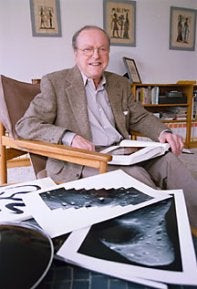
June 24, 2004
Thomas “Tommy” Gold died at the age of 84 in Ithaca, New York, after a long battle with heart disease. An energetic, prominent figure in astronomy celebrated for going against conventional wisdom, Gold’s interests and fields of study were boundless.
Born in Vienna, Gold attended secondary school in Switzerland before relocating to England before WWII for study at Cambridge University. During the war he spent a year in a British internment camp. In 1969, Gold earned his doctorate from Cambridge, although he had served as professor of astronomy at Harvard and then Cornell before receiving the degree.
At Cornell, Gold became the head of the astronomy department and assistant vice president of research. Although he retired from Cornell in 1987, he continued to write and conduct research, more recently with theory that oil and gas are not formed from decaying organic matter, but are products of geological processes that frequently surface from deep underground.
Gold symbolized the image of Cornell as a bastion of unorthodox geniuses, according to Joesph Veverka, chairman of the university’s astronomy department and longtime colleague of Gold. Veverka feels that Gold’s flamboyant, energetic attitude was instrumental in the promotion of Cornell University.

Thomas “Tommy” Gold (1920-2004)
Cornell University
“Tommy was not shy, he was very confident, which made him an influential spokesman for Cornell. He was largely responsible for making modern astronomy at Cornell the first-rate program it is today.”
Though Gold viewed himself as simply fulfilling the role of a scientist, he was labeled as a nonconformist for developing and supporting contrary theories that went against conventional wisdom. Sometimes he proved correct. For example, in 1968 Gold proposed that the newly discovered pulsars were rotating neutron stars, an idea that was initially disputed but which has since become the current model.
However, Gold was not always right. In the 1950s, he suggested that the lunar surface was coated with a deep layer of fine rock powder, warning that astronauts and landers would sink out of sight. The theory was opposed by many planetary scientists, but in part because of Gold’s reputation, NASA sent unmanned missions to test the strength of the lunar surface. Soil samples returned by Apollo 11 astronauts verified that the Moon’s upper surface is fine dust as Gold claimed, but it was only a few inches deep, and landers and astronauts were never in danger of vanishing into it.
Most famous, however, was Gold’s work, with astrophysicists Fred Hoyle and Hermann Bondi — who Gold met in the internment camp — in developing the “steady-state” theory in cosmology, which held that the universe was under constant construction with no beginning or end. Their theory was shattered in the 1960s with the discovery of microwave background radiation and quasars. Gold was disappointed, but not distraught over the failure of the “steady-state” theory and, characteristically unfazed, moved to his next idea.
Veverka shared one of his favorite moments with Gold from the early 1970s, just after Veverka arrived at Cornell. Hoyle was a visiting professor, lecturing a classroom on the arrow of time — which way time is going. Gold adamantly disagreed with Hoyle and came to the front of the classroom where the two battled it out on the chalkboard, vigorously writing equations and trading arguments.
“Tommy was exciting and had a real presence in a classroom — he relished the chance to share and explain his ideas.”
Gold’s boundless energy transcended his professional life. He enjoyed a wide range of activities, including water-skiing, climbing, and even tightrope walking.
“Tommy will be remembered fondly by all of us for his incisive and provocative ideas, for his sincere dedication to his colleagues, as well as for his wide-ranging contributions to physics and astronomy extending over such varied topics as the steady-state theory of the universe, pulsars, the lunar regolith, and the geochemistry of the Earth’s mantle,” says Veverka.









